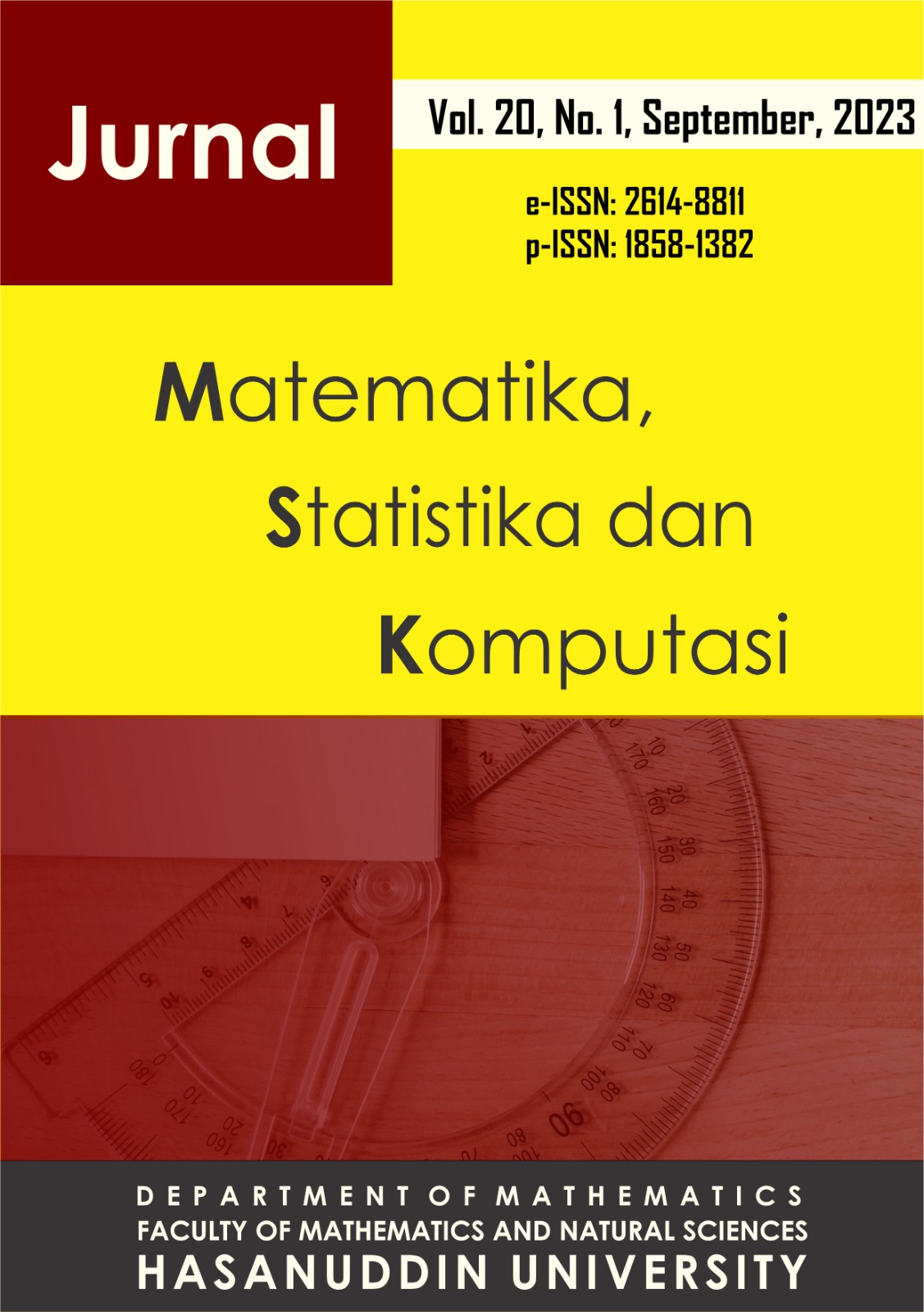Financial Distress Classification Using Feedforward Neural Network Based on Altman and Ohlson Financial Ratios
DOI:
https://doi.org/10.20956/j.v20i1.27742Keywords:
Area Under Curve, Feedforward Neural Network, Financial Distress, Financial RatioAbstract
The ever-changing economy requires companies to anticipate future conditions in order to avoid financial distress, a continuous decline in financial conditions. The research focused on comparing Altman and Ohlson’s financial ratio in classifying financial distress on Property and Real Estate companies using the Feedforward Neural Network. The data used is the financial report data of 19 Property and Real Estate companies listed on the Indonesian Stock Exchange in 2016-2022, with the initial status of financial conditions based on earnings per share. (EPS). The study also used the Synthetic Minority Oversampling Technique (SMOTE) method to address class imbalances. The best financial ratio is selected based on accuracy values and Area Under Curve (AUC). Altman’s financial ratio with the FFNN model architecture (5-2-1) with a balance of 60:40 yields an accuracy of 84.62% and an AUC of 0.8325. The Ohlson Financial ratio with the 60:40 data balancing process and the FFNN model architecture (9-4-1) yields an accuracy of 93.27% and an AUC of 0.9045. Thus, in predicting financial distress in companies in the Property and Real Estate sector, Ohlson’s financial ratio with the predictor variables Corporate Size (SIZE), Total Liabilities to Total Assets (TLTA), Working Capital to Total Acts (WCTA), Current Liability to Current Asset (CLCA), OENEG, Net Income to total assets (NITA), Cash Flows Operating to Total Responsibilities (CFOTL), Net Revenue (INTWO), and Net Incoming Change (CHIN) yielded the best results. This best ratio can be used as a consideration in using alternative financial ratio to classify financial distress.Downloads
References
Altman, E. I. 1968. Financial Ratios, Discriminant Analysis and The Prediction of Corporate Bankruptcy. The Journal of Finance, vol. 23. no 4, pp. 589–609.
Fachrudin, K. A. 2008. Kesulitan Keuangan Perusahaan Dan Personal. USU Press.
Fausett, L. 1969. Fundamentals of neural Netwroks (Architectures, ALgorithms, and Applications). In IEEE Transactions on Computers: vol. C–18, no. 6.
Febriana, K. 2021. Analisis Penggunaan dan Tingkat Akurasi Model Altman Z-Score, Zmijewski (X-Score), dan Springate dalam Memprediksi Financial Distress pada Bank Syariah Devisa dan Non Devisa Periode 2015-2018. Universitas Islam Negeri Walisongo.
Guénette, J. D., Kose, M. A., & Sugawara, N. 2022. Is a Global Recession Imminent? EFI Policy Note 4.
Huang, J., & Ling, C. X. 2005. Using AUC and accuracy in evaluating learning algorithms. IEEE Transactions on Knowledge and Data Engineering, vol. 17, no. 3, pp. 299–310.
Kurniawan, E., Nhita, F., Aditsania, A., & Saepudin, D. 2019. Algorithm and Synthetic Minority Over- sampling Technique ( SMOTE ) for Rainfall Forecasting in Bandung Regency. 2019 7th International Conference on Information and Communication Technology (ICoICT).
Mulyadi, D. 2020. Analysis Prediction of Bankruptcy Business by Using the Method Altman Z-Score and Springate (Case Study in PT Holcim Indonesia TBK). International Journal of Innovation, Creativity and Change, vol. 12, no. 5, pp. 723–735.
Nasution, D. A., Khotimah, H. H., & Chamidah, N. 2019. Perbandingan Normalisasi Data untuk Klasifikasi Wine Menggunakan Algoritma K-NN. Computer Engineering, Science and System Journal, vol. 4, no. 1, p. 78.
Nasution, L. M. 2017. Statistik Deskriptif Leni Masnidar Nasution. Hikmah, vol. 14, no. 1, pp. 49–55.
Ohlson, J. A. 1980. Financial Ratios and the Probabilistic Prediction of Bankruptcy. Journal of Accounting Research, vol. 18, no. 1, pp. 109–131.
Platt, H. D., & Platt, M. B. 2006. Understanding Differences Between Financial Distress and Bankruptcy. Review of Applied Economics, vol. 2, no. 2.
Putri, R., & Saputro, A. H. 2019. Implementation of neural network classification for diabetes mellitus prediction system through iridology image. 2019 6th International Conference on Information Technology, Computer and Electrical Engineering, ICITACEE 2019.
Rahman, M. F., Alamsah, D., Darmawidjadja, M. I., & Nurma, I. 2017. Klasifikasi Untuk Diagnosa Diabetes Menggunakan Metode Bayesian Regularization Neural Network (RBNN). Jurnal Informatika, vol. 11, no. 1, p. 36.
Salim, S. N., & Dillak, V. J. 2021. Pengaruh Ukuran Perusahaan , Biaya Agensi Manajerial , Struktur Modal dan Gender Diversity terhadap Financial Distress. Jurnal Ilmiah MEA (Manajemen, Ekonomi, dan Akuntansi), vol. 5, no. 3, pp. 182–198.
Saputri, P. D., & Oktaviana, P. P. 2023. Comparison of Feedforward Neural Network and Classical Statistics Methods: Application in Finance. Jurnal Matematika, Statistika dan Komputasi, vol. 19, no. 3, pp. 537–548.
Wijaksana, S. 2023. Analisis Perbandingan Klasifikasi Financial Distress Perusahaan Sektor Transportasi Di Bursa Efek Indonesia Menggunakan Artificial Neural Network dan Support Vector Machine. Institut Teknologi Sepuluh Nopember.
Yuniarti, I. 2016. Prediksi Financial Distress Perusahaan Sektor Manufaktur dan Industri Penghasil Bahan Baku Utama yang Terdaftar di BEI menggunakan Analisis Diskriminan, Regresi Logistik Biner, dan Feedforward Neural Network. Institut Teknologi Sepuluh Nopember.
Downloads
Published
How to Cite
Issue
Section
License
Copyright (c) 2023 Author and publisher

This work is licensed under a Creative Commons Attribution 4.0 International License.

This work is licensed under a Creative Commons Attribution 4.0 International License.
Jurnal Matematika, Statistika dan Komputasi is an Open Access journal, all articles are distributed under the terms of the Creative Commons Attribution License, allowing third parties to copy and redistribute the material in any medium or format, transform, and build upon the material, provided the original work is properly cited and states its license. This license allows authors and readers to use all articles, data sets, graphics and appendices in data mining applications, search engines, web sites, blogs and other platforms by providing appropriate reference.








